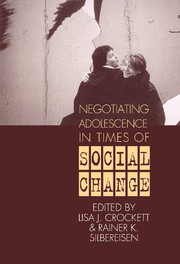Book contents
- Frontmatter
- Contents
- Contributors
- Preface
- 1 Social Change and Adolescent Development: Issues and Challenges
- Part I Models of Social Change Effects
- Part II Social Change and Adolescent Transitions
- Part III Social Change and Adolescents' Social Contexts
- 9 Adolescent Peer Relations in Times of Social Change
- 10 Life Course Dynamics and the Development of New Relations Between Generations
- 11 A Neighborhood-Level Perspective on Social Change and the Social Control of Adolescent Delinquency
- 12 Social Change and the “Social Contract” in Adolescent Development
- Part IV Implications of Social Change for Adolescent Health and Well-Being
- Part V Interventions: Promoting Healthy Development in Times of Social Change
- Endnotes
- Index
9 - Adolescent Peer Relations in Times of Social Change
Published online by Cambridge University Press: 26 January 2010
- Frontmatter
- Contents
- Contributors
- Preface
- 1 Social Change and Adolescent Development: Issues and Challenges
- Part I Models of Social Change Effects
- Part II Social Change and Adolescent Transitions
- Part III Social Change and Adolescents' Social Contexts
- 9 Adolescent Peer Relations in Times of Social Change
- 10 Life Course Dynamics and the Development of New Relations Between Generations
- 11 A Neighborhood-Level Perspective on Social Change and the Social Control of Adolescent Delinquency
- 12 Social Change and the “Social Contract” in Adolescent Development
- Part IV Implications of Social Change for Adolescent Health and Well-Being
- Part V Interventions: Promoting Healthy Development in Times of Social Change
- Endnotes
- Index
Summary
Adolescent Peer Relations in Times of Social Change
Peer relations are an issue of major interest in adolescent research. The role peers play in adolescents' lives and their influence on psychosocial development during the transition to adulthood are well documented. The strength and quality of family–peer linkages, teenagers' susceptibility to peer influence, and the developmental outcomes of parent–peer cross-pressure are but a few well-studied examples. So far, most attention has focused on the qualitative and quantitative nature of peer relations, their consequences, and their proximal antecedents, such as experiences in the family or school. Effects of more distal contextual conditions have mostly been neglected (Furman, 1993; Hartup, 1993). The present study sets out to examine possible variations of peer bonds among adolescents who grew up under considerably different societal conditions, namely in East and West Germany, and to explore influences of social change on relationships with age-mates in both parts of the country, which are differentially affected by societal transformations resulting from German unification.
In the following, studies investigating consequences of social change on the relationship and individual level are reported first. Then, peculiarities of the situation of the two Germanys before the unification of the country as well as changes resulting from the process of unification are addressed. This second section focuses particularly on adolescent peer relations. The third section draws together empirical findings to arrive at some tentative hypotheses for the empirical study of peer relations after German unification reported upon in the remaining part of this chapter.
- Type
- Chapter
- Information
- Negotiating Adolescence in Times of Social Change , pp. 137 - 156Publisher: Cambridge University PressPrint publication year: 1999
- 1
- Cited by

